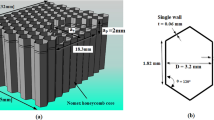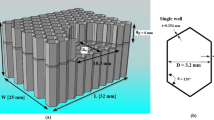Abstract
Machining of Nomex® honeycomb materials is the biggest challenge in industry because of the complex forms and geometry of the honeycomb structure. The latter is characterized by a low density with orthotropic mechanical behavior. The thin walls of the composite structure make the shaping of this material very difficult. Studying interactions between the cutting tool and material, cutting forces, and chip formation allow to understand the machining process of Nomex® honeycomb. This paper presents 3D numerical modeling of machining Nomex® honeycomb using different orthotropic approaches and failure criteria: (i) monolayer isotropic approach, (ii) monolayer orthotropic approach with Tsai-Wu failure criteria, and (iii) monolayer orthotropic approach with Hashin failure criteria. A comparison between experiments and numerical cutting forces was performed to validate the proposed model. The interaction between the tool and the honeycomb walls, which make it possible to observe the different stages of the chip formation process, was carefully modeled.
Graphical abstract






















Similar content being viewed by others
Data availability
All numerical data presented in this paper are available.
References
Lamb AJ (2007) Experimental investigation and numerical modelling of composite-honeycomb materials used in formula 1 crash structures. Dissertation, Cranfield University. https://doi.org/10.1017/CBO9781107415324.004
Fischer S, Drechsler K, Kilchert S, Johnson A (2009) Mechanical tests for foldcore base material properties. Compos Part A 40:1941–1952. https://doi.org/10.1016/j.compositesa
Foo CC, Chai GB, Seah LK (2007) Mechanical properties of Nomex material and Nomex honeycomb structure. Compos Struct 80:588–594. https://doi.org/10.1016/j.compstruct.2006.07.010
Kim DS, Lee JR (1997) Compressive mechanical properties of the nomex/thermoset honeycomb cores. Polym Adv Technol 8:1–7. https://doi.org/10.1002/(SICI)1099-1581(199701)8:1<1::AID-PAT601>3.0.CO;2-G
Zinno A, Prota A, Di Maio E, Bakis CE (2011) Experimental characterization of phenolic-impregnated honeycomb sandwich structures for transportation vehicles. Compos Struct 93:2910–2924. https://doi.org/10.1016/j.compstruct.2011.05.012
Aminanda Y, Castanie B, Barrau JJ, Thevenet P (2009) Experimental and numerical study of compression after impact of sandwich structures with metallic skins. Compos Sci Technol 69:50–59. https://doi.org/10.1016/j.compscitech.2007.10.045
Heimbs S (2008) Sandwichstrukturen mit Wabenkern: Experimentelle und numerische Analyse des Schädigungsverhaltens unter statischer und kurzzeitdynamischer Belastung. Institut für Verbundwerkstoffe GmbH
Hou B, Ono A, Abdennadher S, Pattofatto S, Li YL, Zhao H (2011) Impact behavior of honeycombs under combined shear-compression. Part I: experiments. Int J Solids Struct 48:698–705. https://doi.org/10.1016/j.ijsolstr.2010.11.005
Mohr D, Doyoyo M (2004) Deformation-induced folding systems in thin-walled monolithic hexagonal metallic honeycomb. Int J Solids Struct 41:3353–3377. https://doi.org/10.1016/j.ijsolstr.2004.01.014
Wang Z, Qin Q, Chen S, Yu X, Li H, Wang TJ (2017) Compressive crushing of novel aluminum hexagonal honeycombs with perforations: experimental and numerical investigations. Int J Solids Struct 126:187–195. https://doi.org/10.1016/j.ijsolstr.2017.08.005
Keshavanarayana SR, Shahverdi H, Kothare A, Yang C, Bingenheimer J (2017) The effect of node bond adhesive fillet on uniaxial in-plane responses of hexagonal honeycomb core. Compos Struct 175:111–122. https://doi.org/10.1016/j.compstruct.2017.05.010
Zhang ZJ, Han B, Zhang QC, Jin F (2017) Free vibration analysis of sandwich beams with honeycomb-corrugation hybrid cores. Compos Struct 171:335–344. https://doi.org/10.1016/j.compstruct.2017.03.045
Nasution MRE, Watanabe N, Kondo A (2015) Numerical study on thermal buckling of CFRP–Al honeycomb sandwich composites based on homogenization–localization analysis. Compos Struct 132:709–719. https://doi.org/10.1016/j.compstruct.2015.06.009
Lhuissier P, Laszczyk L (2012) Caractérisation des structures sandwich. Tech l’Ingénieur, Ref M5815:v1
Hosseini SMH, Gabbert U (2013) Numerical simulation of the Lamb wave propagation in honeycomb sandwich panels: a parametric study. Compos Struct 97:189–201. https://doi.org/10.1016/j.compstruct.2012.09.055
Manet V (2012) The use of Ansys to calculate sandwich structures. arXiv. preprint arXiv 58:1899–1905. https://doi.org/10.1016/S0266-3538(98)00010-4
Bianchi G, Aglietti GS, Richardson G (2012) Static and fatigue behaviour of hexagonal honeycomb cores under in-plane shear loads. Appl Compos Mater 19(2):97–115. https://doi.org/10.1007/s10443-010-9184-5
Seemann R, Krause D (2017) Numerical modelling of Nomex honeycomb sandwich cores at meso-scale level. Compos Struct 159:702–718. https://doi.org/10.1016/j.compstruct.2016.09.071
Foo CC, Chai GB, Seah LK (2008) A model to predict low-velocity impact response and damage in sandwich composites. Compos Sci Technol 68(6):1348–1356. https://doi.org/10.1016/j.compscitech.2007.12.007
Mancha ÁJ (2012) Optimization of lightweight sandwich structures of commercial aircraft interior parts subjected to low-velocity impact. Universidad Pontificia Comillas Madrid, Escuela Tecnica Superior de Ingenierla (ICAI)
Iváñez del Pozo I, Moure Cuadrado MM, García Castillo SK, Sánchez Sáez S. (2015) The oblique impact response of composite sandwich plates. doi:https://doi.org/10.1016/j.compstruct.2015.08.035
Zhu S, Chai GB (2013) Damage and failure mode maps of composite sandwich panel subjected to quasi-static indentation and low velocity impact. Compos Struct 101:204–214. https://doi.org/10.1016/j.compstruct.2013.02.010
Roy R, Kweon JH, Choi JH (2014) Meso-scale finite element modeling of NomexTM honeycomb cores. Adv Compos Mater 23(1):17–29. https://doi.org/10.1080/09243046.2013.862382
Roy R, Park SJ, Kweon JH, Choi JH (2014) Characterization of Nomex honeycomb core constituent material mechanical properties. Compos Struct 117:255–266. https://doi.org/10.1016/j.compstruct.2014.06.033
Heimbs S (2009) Virtual testing of sandwich core structures using dynamic finite element simulations. Comput Mater Sci 45(2):205–216. https://doi.org/10.1016/j.commatsci.2008.09.017
Roy R, Nguyen KH, Park YB, Kweon JH, Choi JH (2014) Testing and modeling of Nomex™ honeycomb sandwich Panels with bolt insert. Compos Part B 56:762–769. https://doi.org/10.1016/j.compositesb.2013.09.006
Kilchert S (2013) Nonlinear finite element modelling of degradation and failure in folded core composite sandwich structures. Faculty of Aerospace Engineering and Geodesy of the Universität Stuttgart, Dissertation
Seemann RALF, Krause DIETER (2014) Numerical modelling of nomex honeycomb cores for detailed analyses of sandwich panel joints. In 11th World Congress on Computational Mechanics (WCCM XI)
Asprone D, Auricchio F, Menna C, Morganti S, Prota A, Reali A (2013) Statistical finite element analysis of the buckling behavior of honeycomb structures. Compos Struct 105:240–255. https://doi.org/10.1016/j.compstruct.2013.05.014
Gornet L, Marguet S, Marckmann G (2007) Modeling of Nomex® honeycomb cores, linear and nonlinear behaviors. Mech Adv Mater Struct 14(8):589–601. https://doi.org/10.1080/15376490701675370
Hähnel F, Wolf K (2008) Simulation of the damage tolerance behaviour of CFRP/Honeycomb sandwich based on measured properties of the resin impregnated core paper. In Proc. of the 13th International Conference on Composite Materials, Stockholm. doi:https://doi.org/10.1007/978-3-540-79432-5
Aktay L, Johnson AF, Kröplin BH (2008) Numerical modelling of honeycomb core crush behaviour. Eng Fract Mech 75(9):2616–2630. https://doi.org/10.1016/j.engfracmech.2007.03.008
Giglio M, Manes A, Gilioli A (2012) Investigations on sandwich core properties through an experimental–numerical approach. Compos Part B 43(2):361–374. https://doi.org/10.1016/j.compositesb.2011.08.016
Qiu K, Ming W, Shen L, An Q, Chen M (2017) Study on the cutting force in machining of aluminum honeycomb core material. Compos Struct 164:58–67. https://doi.org/10.1016/j.compstruct.2016.12.060
Sun J, Dong Z, Wang X, Wang Y, Qin Y, Kang R (2020) Simulation and experimental study of ultrasonic cutting for aluminum honeycomb by disc cutter. Ultrasonics 103:1–8. https://doi.org/10.1016/j.ultras.2020.106102
Nasir MA, Khan Z, Farooqi I, Nauman S, Anas S, Khalil S, Pasha A, Khan Z, Shah M, Qaiser H, Ata R (2015) Transverse shear behavior of a nomex core for sandwich panels. Mech Compos Mater 50:733–738. https://doi.org/10.1007/s11029-015-9462-2
Paris F, Jackson KE (2001) A study of failure criteria of fibrous composite materials
Padhi GS, Shenoi RA, Moy SSJ, Hawkins GL (1997) Progressive failure and ultimate collapse of laminated composite plates in bending. Compos Struct 40:277–291. https://doi.org/10.1016/S0263-8223(98)00030-0
Perillo G, Vedvik NP, Echtermeyer AT (2011) Numerical application of three-dimensional failure criteria for laminated composite materials. Norwegian University of Science and Technology (NTNU), Department of Engineering Design and Materials, pp 5–6
Guo-dong JL, Bao-lai W (2009) Progressive damage and nonlinear analysis of 3D four-directional braided composites under unidirectional tension. Compos Struct 89:126–133. https://doi.org/10.1016/j.compstruct.2008.07.016
Zhao L, Qin T, Chen Y, Zhang J (2014) Three-dimensional progressive damage models for cohesively bonded composite joint. J Compos Mater 48:707–721. https://doi.org/10.1177/0021998313477169
Zenia S (2017) Modélisation numérique de l’usinage des matériaux composites à matrice polymère et fibres longues de carbone. PhD thesis, Université de Lorraine
Zenia S, Ben Ayed L, Nouari M, Delamézière A (2015) Numerical prediction of the chip formation process and induced damage during the machining of carbon/epoxy composites. Int J Mech Sci 90:89–101. https://doi.org/10.1016/j.ijmecsci.2014.10.018
Lasri L, Nouari M, El Mansori M (2009) Modelling of chip separation in machining unidirectional FRP composites by stiffness degradation concept. Compos Sci Technol 69:684–692. https://doi.org/10.1016/j.compscitech.2009.01.004
Boutrih L, Ayed L Ben, Nouari M. (2021) Modeling of the interface delamination process when machining hybrid multi-material assemblies. Int J Adv Manuf Technol 112:1903–1916. https://doi.org/10.1007/s00170-020-06531-z
Liu PF, Zheng JY (2008) Progressive failure analysis of carbon fiber/epoxy composite laminates using continuum damage mechanics. Mater Sci Eng A 485:711–717. https://doi.org/10.1016/j.msea.2008.02.023
Gemkow KS, Vignjevic R (2013) Strain-softening in continuum damage models : investigation of MAT _ 058. 9th Euopean LS-DYNA Conf
Chai GB, Zhu SA (2011) Review of low-velocity impact on sandwich structures. Proceedings of the Institution of Mechanical Engineers, Part L: Journal of Materials: Design and Applications, n.d.:1–54
Jaafar M, Atlati S, Makich H, Nouari M, Moufki A, Julliere B (2017) A 3D FE modeling of machining process of Nomex® honeycomb core: influence of the cell structure behaviour and specific tool geometry. Procedia CIRP 58:505–510. https://doi.org/10.1016/j.procir.2017.03.255
Acknowledgements
The authors wish to express their thanks and appreciation to the members of the following organizations for their financial support: Evatec-tools group and National French Research Agency (ANR). LARIOPAC Labcom project under Grant No. ANR-13-LAB2-0002.
Funding
No funding was obtained for this work except the salary of the PhD student given by the French Ministry of high education and research.
Author information
Authors and Affiliations
Contributions
M. Jaafar obtained his PhD from LEM3 Laboratory at Lorraine University and performed in this work the literature study of this area of research and performed the model for numerical simulations. He also participated to writing the paper.
Nouari is a full professor and the first supervisor of the work. He provided fundamental ideas and all needed support conditions. M. Nouari organized the proof reading and critical revisions.
H. Makich is currently an associate professor and the second supervisor of this thesis project. He was in charge the experimental validation of the model. All authors read and approved the final manuscript.
M. Moufki is a full professor; his contribution to the work concerns the preparation of simulations. He also participates to the organization of the proof reading and critical revisions
All authors participated to read and approve the final manuscript.
Corresponding author
Ethics declarations
Ethical approval
All ethical responsibilities were respected by the authors.
Consent to participate
All authors contribute and participate to work carried out in article.
Consent to publish
The authors of this paper agree to publish the results of this work carried out in the thesis of M. Jaafar.
Competing interests
The authors declare no competing interests.
Additional information
Publisher’s note
Springer Nature remains neutral with regard to jurisdictional claims in published maps and institutional affiliations.
Rights and permissions
About this article
Cite this article
Jaafar, M., Nouari, M., Makich, H. et al. 3D numerical modeling and experimental validation of machining Nomex® honeycomb materials. Int J Adv Manuf Technol 115, 2853–2872 (2021). https://doi.org/10.1007/s00170-021-07336-4
Received:
Accepted:
Published:
Issue Date:
DOI: https://doi.org/10.1007/s00170-021-07336-4




